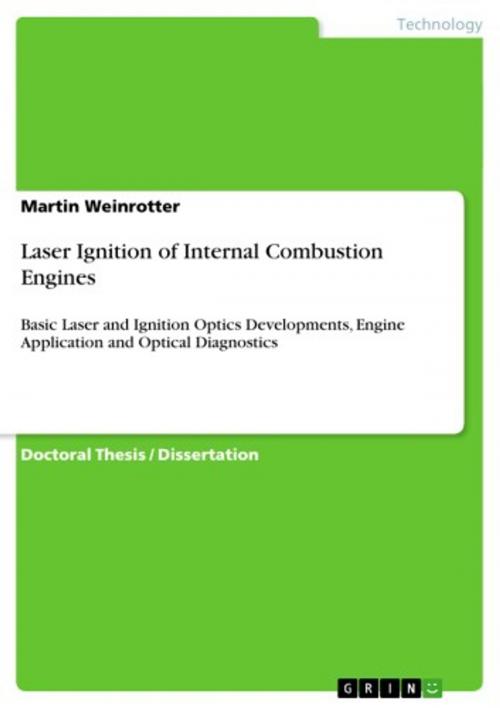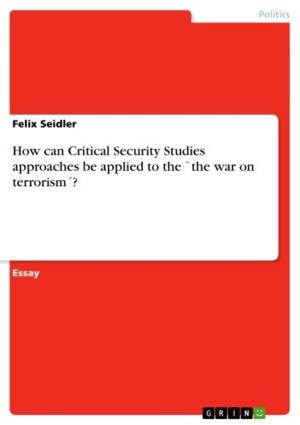Laser Ignition of Internal Combustion Engines
Basic Laser and Ignition Optics Developments, Engine Application and Optical Diagnostics
Nonfiction, Science & Nature, Technology, Electricity| Author: | Martin Weinrotter | ISBN: | 9783640881345 |
| Publisher: | GRIN Publishing | Publication: | March 31, 2011 |
| Imprint: | GRIN Publishing | Language: | English |
| Author: | Martin Weinrotter |
| ISBN: | 9783640881345 |
| Publisher: | GRIN Publishing |
| Publication: | March 31, 2011 |
| Imprint: | GRIN Publishing |
| Language: | English |
Doctoral Thesis / Dissertation from the year 2006 in the subject Electrotechnology, grade: 1, mit Ausgezeichnung bestanden, Vienna University of Technology (Insitut für Photonik), language: English, abstract: In this PhD thesis different fundamental aspects and the practical usability of a laser ignition system as a new, innovative and alternative ignition approach for internal combustion engines were investigated in great detail mainly experimentally. Ignition experiments in combustion chambers under high pressures and elevated temperatures have been conducted. Different fuels were investigated. Also the minimum breakdown energy in dependence of the initial temperature and pressure with the help of an aspheric lens with a high numerical aperture was studied. High-speed Schlieren diagnostics have been conducted in the combustion chamber. The different stages like the ignition plasma within the first nanoseconds via the shock wave generation to the expanding flame kernel were investigated. With the help of multi-point ignition the combustion duration could be reduced significantly. The controlled start of auto-ignition of n-heptane-air mixtures by resonant absorption of Er,Cr:YSGG laser radiation at 2.78 µm by additionally introduced water has been proven in combustion chamber experiments as a completely new idea. Beside experiments in the combustion chambers and long term tests under atmospheric conditions, various tests in SI engines up to 200 h, have been made. Different sources of contamination of the window surface have been identified. First experiments with a longitudinally diode-pumped, fiber-coupled and passively Q-switched solid-state laser ?-prototype system with maximum pulse energy of 1.5 mJ at about 1.5 ns pulse duration were performed which allowed to ignite the engine successfully over a test period of 100 h. In cooperation with Lund University in Sweden, experiments have been performed on another engine test bed running in HCCI mode revealing the laser spark to be able to stimulate the auto-ignition process and to trigger the onset of combustion. In another international cooperation conducted with the Southwest Research Institute in Texas, U.S.A., the potential of laser ignition in combination with the so called HEDGE concept was studied. As a final direction of the work, first calculations and experiments of a ?- prototype ignition laser of an own design have been conducted. The concept of a longitudinally diode-pumped, fiber-coupled and passively Q-switched solid-state laser was chosen as the most promising. Emitted pulse energy of 2 mJ within around 1 ns pulse duration was achieved easily allowing generating a laser-induced breakdown in air.
Doctoral Thesis / Dissertation from the year 2006 in the subject Electrotechnology, grade: 1, mit Ausgezeichnung bestanden, Vienna University of Technology (Insitut für Photonik), language: English, abstract: In this PhD thesis different fundamental aspects and the practical usability of a laser ignition system as a new, innovative and alternative ignition approach for internal combustion engines were investigated in great detail mainly experimentally. Ignition experiments in combustion chambers under high pressures and elevated temperatures have been conducted. Different fuels were investigated. Also the minimum breakdown energy in dependence of the initial temperature and pressure with the help of an aspheric lens with a high numerical aperture was studied. High-speed Schlieren diagnostics have been conducted in the combustion chamber. The different stages like the ignition plasma within the first nanoseconds via the shock wave generation to the expanding flame kernel were investigated. With the help of multi-point ignition the combustion duration could be reduced significantly. The controlled start of auto-ignition of n-heptane-air mixtures by resonant absorption of Er,Cr:YSGG laser radiation at 2.78 µm by additionally introduced water has been proven in combustion chamber experiments as a completely new idea. Beside experiments in the combustion chambers and long term tests under atmospheric conditions, various tests in SI engines up to 200 h, have been made. Different sources of contamination of the window surface have been identified. First experiments with a longitudinally diode-pumped, fiber-coupled and passively Q-switched solid-state laser ?-prototype system with maximum pulse energy of 1.5 mJ at about 1.5 ns pulse duration were performed which allowed to ignite the engine successfully over a test period of 100 h. In cooperation with Lund University in Sweden, experiments have been performed on another engine test bed running in HCCI mode revealing the laser spark to be able to stimulate the auto-ignition process and to trigger the onset of combustion. In another international cooperation conducted with the Southwest Research Institute in Texas, U.S.A., the potential of laser ignition in combination with the so called HEDGE concept was studied. As a final direction of the work, first calculations and experiments of a ?- prototype ignition laser of an own design have been conducted. The concept of a longitudinally diode-pumped, fiber-coupled and passively Q-switched solid-state laser was chosen as the most promising. Emitted pulse energy of 2 mJ within around 1 ns pulse duration was achieved easily allowing generating a laser-induced breakdown in air.















